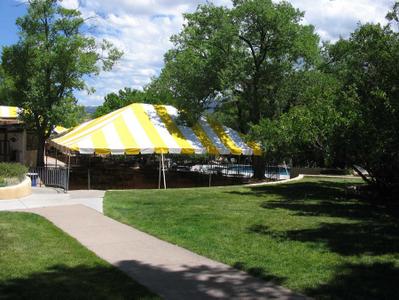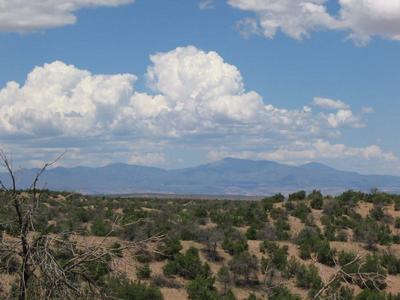Ionarts at Santa Fe Opera
John Crosby had a vision when he looked at a pig ranch next to the Tesuque Indian Reservation, just outside Santa Fe. He had been a student at the famous Ranch School in the Jemez Mountains, a challenging boarding school in the town of Los Alamos, a place that almost no one had heard of until the U.S. government brought the top-secret Manhattan Project here to New Mexico and started what became known as the Los Alamos National Laboratory. (For more on that story, the creation of the most devastating weapon in military history, we are all waiting with great anticipation for the premiere of John Adams’s new opera, Dr. Atomic, in San Francisco this fall.) Building the lab in 1943 meant closing the Ranch School, but Crosby never forgot this area of the country. He came back to Santa Fe to create a visionary American opera company, one that would mount productions in the summer; that would do so with up-and-coming singers, mostly Americans; and that would host that group of singers as a resident ensemble for the duration of the summer season. He was lucky to receive a large sum of money from his family, with which he bought that disaster of a pig farm, a place that was pretty much in ruins, after years of attempts by owners to grow pinto beans, chickens, pigs. It has become known as The Ranch, a complex of buildings clustered around the opera theater on the elevation overlooking the valley below. He built places to live, offices, rehearsal spaces, and a place to eat (eating, any musician will tell you, is very important). As I learned on a tour of the Santa Fe Opera campus this morning, there is even a pool, very inviting in the hot, dry air of a New Mexico summer, for the families and spouses of the company. Rehearsals take place in small studio buildings or, when the work is at a sufficient stage, at the North Theater, a building across the Great Lawn from the pool, with a stage the precise dimensions of the real theater.
He was lucky to receive a large sum of money from his family, with which he bought that disaster of a pig farm, a place that was pretty much in ruins, after years of attempts by owners to grow pinto beans, chickens, pigs. It has become known as The Ranch, a complex of buildings clustered around the opera theater on the elevation overlooking the valley below. He built places to live, offices, rehearsal spaces, and a place to eat (eating, any musician will tell you, is very important). As I learned on a tour of the Santa Fe Opera campus this morning, there is even a pool, very inviting in the hot, dry air of a New Mexico summer, for the families and spouses of the company. Rehearsals take place in small studio buildings or, when the work is at a sufficient stage, at the North Theater, a building across the Great Lawn from the pool, with a stage the precise dimensions of the real theater. The Crosby Theater, shown here as I saw it on the night of the Lucio Silla performance, just before curtain, is one of the most attractive venues in the world. Although it used to be almost entirely uncovered, the most recent building here was to make the roof that completely covers the stage and seating area. Since it is still mostly open on the sides of the theater and, depending on the set in use at the time, through the back of the stage, the view of the Jemez Mountains can be spectacular when you arrive at dusk. Often, the sheet lightning in the distance and occasional real storms can add to the drama on stage.
The Crosby Theater, shown here as I saw it on the night of the Lucio Silla performance, just before curtain, is one of the most attractive venues in the world. Although it used to be almost entirely uncovered, the most recent building here was to make the roof that completely covers the stage and seating area. Since it is still mostly open on the sides of the theater and, depending on the set in use at the time, through the back of the stage, the view of the Jemez Mountains can be spectacular when you arrive at dusk. Often, the sheet lightning in the distance and occasional real storms can add to the drama on stage.
Today, we walked up to the Crosby Theater and saw the backstage, where the sets and small boat for Peter Grimes, set to open this Saturday, were stored. (The final dress rehearsal had been the previous evening, because there are no performances on Thursdays in July.) On the stage were the colorful, abstract set pieces painted completely by the muralist Gronk back in April. Gronk did some set designs for Los Angeles Opera, met Peter Sellars, and the two are collaborating for the Santa Fe production of Osvaldo Golijov's Ainadamar (based on the life of poet Federico García Lorca and premiered at Tanglewood), which opens next weekend, sadly after I return to Washington. We stood right behind director Peter Sellars, as he listened to the rehearsal with the composer and other artistic staff. On the stage, soprano Dawn Upshaw and other members of the cast, including Anne-Carolyn Bird (who writes an interesting blog called The Concert, found in our Blogville list), were rehearsing the opera with the conductor and a pianist in the pit. I don’t want to say much more about this, since the opera is still in rehearsal, but it sounded beautiful, and I am very sorry not to be able to hear it performed. Anne-Carolyn is in the Santa Fe Opera Apprentice Singer Program, which Crosby himself put in place when he founded the company. Alumni of the program include some names you will probably recognize, like James Morris, Samuel Ramey, Ashley Putnam, Neil Shicoff, Laura Aikin, Michelle de Young, Beth Clayton, William Burden, Kurt Streit, Celena Shafer, and Joyce DiDonato. Anne-Carolyn has written some great posts about the experience on her blog, and I know that the Ranch campus is a big part of the appeal for apprentices and big name singers who come here. Similar programs for the technical side of opera production (scenic design, props, carpentry, sound, costumes, wigs) were added later, as we got to see on a quick tour of the scene and costume shop area. Most of the costumes and sets are made right here, which creates the best sort of atmosphere to learn about any facet of producing an opera, seeing it all from start to finish.
Anne-Carolyn is in the Santa Fe Opera Apprentice Singer Program, which Crosby himself put in place when he founded the company. Alumni of the program include some names you will probably recognize, like James Morris, Samuel Ramey, Ashley Putnam, Neil Shicoff, Laura Aikin, Michelle de Young, Beth Clayton, William Burden, Kurt Streit, Celena Shafer, and Joyce DiDonato. Anne-Carolyn has written some great posts about the experience on her blog, and I know that the Ranch campus is a big part of the appeal for apprentices and big name singers who come here. Similar programs for the technical side of opera production (scenic design, props, carpentry, sound, costumes, wigs) were added later, as we got to see on a quick tour of the scene and costume shop area. Most of the costumes and sets are made right here, which creates the best sort of atmosphere to learn about any facet of producing an opera, seeing it all from start to finish. John Crosby ran the company with his unique visionary perspective until a few years ago when he retired; sadly, he died very shortly after his retirement. Under new general director Richard Gaddes, who succeeded Crosby in 2000, the Santa Fe tradition continues this season, with two chestnuts in interesting productions (Turandot and Barber of Seville), a staggering production of a little-known Mozart opera (Lucio Silla, which I reviewed Wednesday night), a 20th-century masterpiece (Peter Grimes, which I will see Saturday), and a contemporary work, already premiered but significantly revised for Santa Fe (Ainadamar). Performances continue through August 27, and this part of the United States offers every possible reason, cultural and otherwise, to make a visit here, especially if you love opera.
John Crosby ran the company with his unique visionary perspective until a few years ago when he retired; sadly, he died very shortly after his retirement. Under new general director Richard Gaddes, who succeeded Crosby in 2000, the Santa Fe tradition continues this season, with two chestnuts in interesting productions (Turandot and Barber of Seville), a staggering production of a little-known Mozart opera (Lucio Silla, which I reviewed Wednesday night), a 20th-century masterpiece (Peter Grimes, which I will see Saturday), and a contemporary work, already premiered but significantly revised for Santa Fe (Ainadamar). Performances continue through August 27, and this part of the United States offers every possible reason, cultural and otherwise, to make a visit here, especially if you love opera.
Next season is the 50th anniversary of Santa Fe Opera, and the season looks much more interesting than what, for example, Washington National Opera planned for its 50th anniversary season: two chestnuts (Carmen, with Anne Sofie von Otter, and The Magic Flute, with Natalie Dessay in her first Pamina), a lesser-known Massenet opera (Cendrillon, which I heard in Washington this summer), a 20th-century masterpiece (Salome, in tribute to John Crosby, who programmed a Strauss opera almost every season he was general director, including six American premieres), and an American premiere (The Tempest by Thomas Adès, staged by the same team that did such a marvelous job with Lucio Silla this summer). Perhaps there is a formula for success in use at Santa Fe, the 2/2/1 rule? The only thing missing from what would make Santa Fe the perfect opera company in my eyes is Baroque opera. It's not that they have never done Baroque works at Santa Fe (four Handel operas, three Cavalli operas over the years, but only one Monteverdi opera, Poppea back in 1996), but not that much or that often. I guess there is always room for improvement, even here.





















































No comments:
Post a Comment